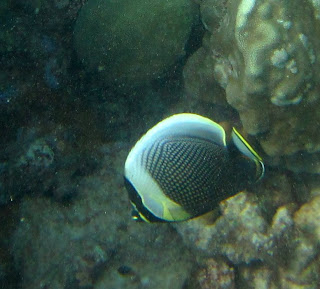 |
| James and Tara, Antediluvian and Ready to Hike |
So let's turn the page a year or so ahead to the present. Two days ago Sandra, Andrew and your's truly, hiked the trail. It was a gorgeous day and the descent was very much like climbing down the Space Needle. This isn't surprising, as from top to bottom the vertical distance is roughly the same. At the bottom we lounged for a while in the shade of the casaurina trees, hard by the shingle beach. The way back up was steep, dusty and hot. Andy had made a point of bringing lots of water and a surprising quantity was consumed on this ascent. The pertinent point is that the Redoubtable SKG and I made it back to the car by the skin on our teeth. Suffice it to say, we have no
 |
| Sandra descending the Pololu Overlook Trail |
Andrew, on the other hand, thought it was a breeze. So much so that yesterday he decided that nothing would answer but to hike the trail to the Captain Cook Monument. Every time we have driven to the city of Refuge, down old Napoopoo Road, we have passed the trail head. Though it is poorly marked, we always know that it is there, and there are invariably a few cars parked, indicating that someone is hiking the trail. As I get tired just driving back up the road from the beach to Hwy 11, I have assumed that the trail was only for the insane. This just goes to show that I am, at heart, a non-hiker.
From Andy's perspective, a young man who hiked into and out of the Grand Canyon in a day, the 1300 ft descent seemed less than daunting. As the portion of Kealakekua Bay adjacent to the monument is a renowned spot for viewing reef fish, I thought you might be interested in the particulars of the hike.
We arrived at the trail head at about 9:30. There were road workers right at the spot where our hiker needed to disembark, affording the opposing drivers the opportunity to flip us the Indian Good Luck Sign as we made the transfer. The following is my nephew's report on the hike.
 |
| Andrew on the Pololu Trail |
Amazingly, he found the hike less demanding than he expected, which is not to say that it wasn't demanding. He made it to the bottom in a shade over an hour, carrying four liters of water and his snorkeling gear. The footing was adequate, never treacherous. The distance was two miles. For the majority of this distance, the trail was was over lava, smoother at the top than the bottom. There were no spots where he was forced to hike over loose stones. Andy met several hikers at this early hour already on their way back up.
At the monument, Andrew met a few fellow hikers. One couple pointed out a spot on the concrete jetty in front of the monument best for entry at low tide. Another hiker had an app on his phone
 |
| Saddleback Butterflyfish, Kahalu'u, February 2013 |
The most significant thing about the snorkeling, from our hero's perspective, was the large number of boats coming and going, and the mob of tourists disgorged by same. They wore life vests, noodles and water wings. They flopped furiously and exclaimed to each other about all the pretty fish. Of course, Sandra and I could eat for a week on what just one of these people paid to swim at the monument. Or to put it another way, they were highly motivated to enjoy themselves. The water was very clear, but just like everywhere else, the number and variety of fish was a bit disappointing. The best fish Andy saw was a single Saddleback
 |
| The Trail to Captain Cook Monument AWH |
The trail back up was steep but safe, and Andrew was able to manage the long steep walk in about 75 minutes. So the bottom line here is, if you are fit enough for the steep two mile hike, there is no reason not to make this hike. As we discovered at the Pololu Lookout, Andrew was right on: Take plenty of water! If you are looking for a challenging hike through arid countryside to a beautiful bay, this may be for you. But making this hike for superior snorkeling and fish watching is probably a mistake. For this purpose, Ho'okena, the Dog Beach and even K Bay and the pier will probably yield a larger list of species. Unless you keep track of every dilettante geek floating on a noodle.
 | |
| The Flotilla at Captain Cook Monument. Board the Sailboat for an Apres la Swim BBQ! |





















